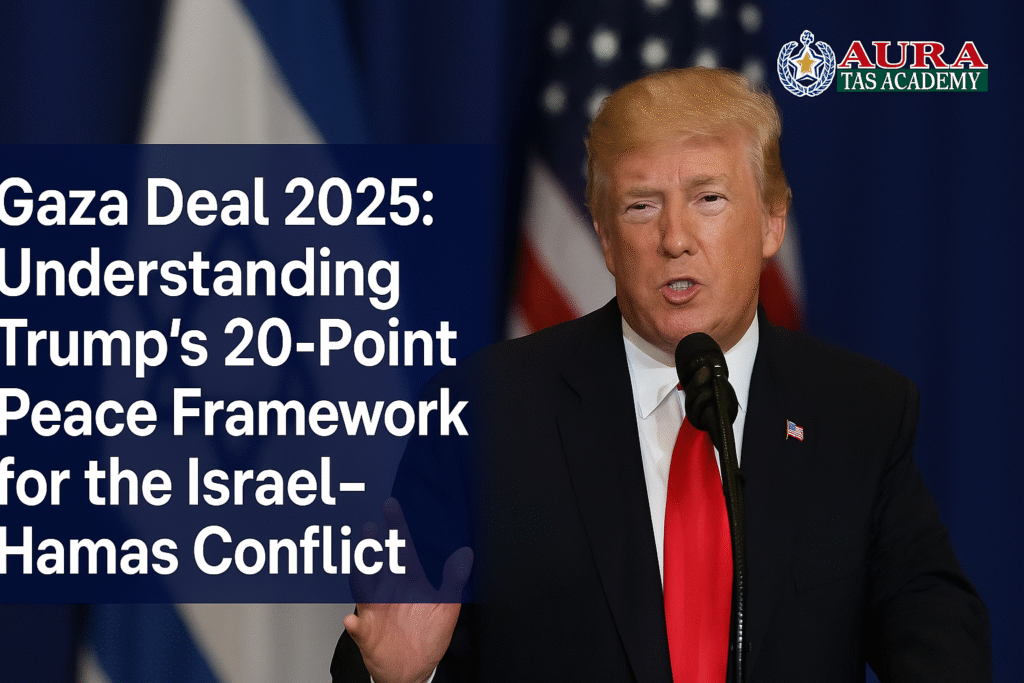Gaza Deal 2025: Understanding Trump’s 20-Point Peace Framework for the Israel–Hamas Conflict

In a major diplomatic development, former U.S. President Donald Trump unveiled a 20-point framework aimed at ending the long-standing Israel–Hamas conflict in Gaza, marking a renewed attempt to bring stability to one of the most volatile regions in the world.
The proposed plan — known informally as the “Gaza Deal 2025” — outlines political, humanitarian, and security measures to de-escalate hostilities and pave the way for peace.
For UPSC aspirants, the issue is significant for GS Paper 2 (International Relations), particularly under India–West Asia relations and global peace initiatives.
Background: The Gaza Crisis
The Israel–Hamas conflict, reignited in October 2023, has resulted in severe humanitarian devastation in Gaza.
Key outcomes include:
Over 35,000 civilian casualties, massive displacement, and destruction of infrastructure.
Widespread condemnation from the UN, EU, and Arab League.
Mounting pressure on both sides to agree to a ceasefire and reconstruction plan.
Trump’s proposed framework seeks to combine security guarantees for Israel with humanitarian relief and governance reforms for Gaza — drawing global attention to a potential turning point.
Key Highlights of Trump’s 20-Point Gaza Framework
The proposed framework includes three major pillars:
🕊️ 1. Immediate Ceasefire and Humanitarian Access
90-day ceasefire to halt all military operations.
Creation of a “Gaza Humanitarian Corridor” under U.S. and UN monitoring.
Evacuation and treatment of injured civilians.
🏗️ 2. Governance and Reconstruction Plan
Establishment of an Interim Administrative Council in Gaza, excluding Hamas leadership.
$50 billion reconstruction fund contributed by the U.S., UAE, Saudi Arabia, and EU.
Gradual reopening of border crossings with international oversight.
🛡️ 3. Security and Long-Term Stability
Complete disarmament of militant groups under international verification.
Deployment of a multinational peacekeeping force along Gaza’s perimeter.
10-year non-aggression pact guaranteed by the U.S. and Arab partners.
Regional and Global Reactions
🇮🇱 Israel:
Mixed response — while Israel supports the security-first approach, it remains skeptical about international monitoring forces.
🇵🇸 Palestine:
The Palestinian Authority has cautiously welcomed the proposal but insists that any peace deal must include a clear path to statehood.
🇺🇸 United States:
Trump’s move is seen as an attempt to revive U.S. influence in West Asia, positioning Washington once again as a peace broker.
🌐 International Community:
UN: Appreciated the emphasis on humanitarian aid and ceasefire.
Arab States: Welcomed reconstruction funding but wary of Western dominance in regional negotiations.
EU: Urged inclusion of human rights safeguards in implementation.
Impact on India and West Asia
For India, peace in the Middle East is critical for:
Energy Security: 60% of India’s crude oil imports come from the region.
Diaspora Safety: Over 9 million Indians live in the Gulf.
Trade & Connectivity: Stability supports initiatives like the India–Middle East–Europe Economic Corridor (IMEC).
India has consistently supported a two-state solution, calling for peaceful coexistence between Israel and Palestine based on mutual recognition and security.
UPSC Relevance
GS Paper 2: International Relations, India and West Asia, Global Peace Initiatives
Essay Paper: “Conflict and Cooperation in a Multipolar World”
Ethics Paper: Humanitarian Diplomacy & Global Responsibility
💡 UPSC Mains Question Example:
“Discuss the strategic significance of peace in West Asia for India’s foreign policy and energy security.”
Challenges to Implementation
Despite optimism, the plan faces multiple obstacles:
⚠️ Lack of trust between Israel and Hamas factions.
⚠️ Political polarization within Palestine.
⚠️ Risk of extremist resurgence.
⚠️ Divergent interests of regional powers like Iran, Egypt, and Saudi Arabia.
These factors could slow or derail progress, despite international support.
Conclusion
The Gaza Deal 2025 may not be a final solution, but it represents a symbolic step toward dialogue in a region long torn by war and mistrust.
For UPSC aspirants, the episode demonstrates how diplomacy, economics, and humanitarian policy intersect in global geopolitics.
Peace in Gaza is not just about ceasefire — it’s about rebuilding trust, governance, and human dignity in a fractured world.
📘 For UPSC Aspirants – Recommended Reading
Aura IAS GS Paper 2 – International Relations PYQs (2013–2025)
✔️ Detailed model answers on India–West Asia policy and peace diplomacy
✔️ Expert analysis of recent global conflicts
🛒 Get it here:
👉 https://auraias.in/shop/



